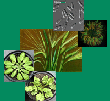| Mustroph, A; Barding, GA; Kaiser, KA; Larive, CK; Bailey-Serres, J: Characterization of distinct root and shoot responses to low-oxygen stress in Arabidopsis with a focus on primary C- and N-metabolism, Plant Cell and Environment, 37(10), 2366-2380 (2014), doi:10.1111/pce.12282 | |
| Abstract: Oxygen deficiency, caused by flooding of all or a portion of a plant, leads to significant gene regulatory and metabolic responses associated with survival. When oxygen-deprived in light, aerial organs and root systems respond in distinct manners because of their respective autotrophy and heterotrophy, as well as intrinsic differences in cell biology and organ function. To better understand organ-specific responses to oxygen deficiency, we monitored changes in the metabolome of roots and shoots of Arabidopsis thaliana seedlings using gas chromatography–mass spectrometry and 1H-nuclear magnetic resonance spectroscopy. Only roots accumulated high amounts of γ-aminobutyrate (GABA) and lactate, whereas both organs accumulated alanine (Ala) upon hypoxia. Meta-analysis of gene regulation data revealed higher induction of mRNAs coding for fermentative enzymes in roots as compared with shoots. However, the elevation in GABA level was not correlated with changes in transcript abundance, supporting the proposal that post-translational mechanisms are important in metabolic acclimation to hypoxia. The biosynthesis, degradation and function of GABA and Ala during oxygen deprivation and re-aeration is discussed. Finally, a systematic survey of low-oxygen mediated regulation of genes associated with primary metabolism across organs and cell types reveals exciting new avenues for future studies. |

